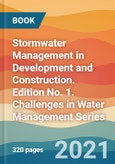Increases in urban development and the built environment have the potential of altering the hydrology and the rainfall/runoff relationship of entire regions. This book presents a comprehensive approach to land development and construction related activities to stormwater and runoff.
This book provides a practical introductory look at impacts of land development on the hydrology of an area. It examines these impacts on a micro scale and at the watershed level. The book examines stormwater dynamics of a site during the development process as well as post-development. It discusses tools and methods for remediation of these impacts, including erosion and sediment control, pollution prevention, and the use of stormwater best management practices that address stormwater quality, quantity and infiltration during and after construction.
Topics covered in this book include a discussion on hydrology as it relates to construction, site planning, erosion and sediment control, pollution prevention, and stormwater management using conventional and innovative techniques, including Low Impact Development.
Current books on the subject of construction and stormwater management mostly deal with post construction stormwater hydrology, hydraulics and issues of moving stormwater from the site as quickly as possible. The majority of these books on stormwater address engineering concepts including items such as fluid mechanics, hydrostatics, hydrodynamics, channel flow, routing, culvert design, and stormwater detention. A few more recent books were written on the subject of low impact development (LID) and its influence on stormwater management. While the physical change to the landscape and the resulting changes in site hydrology are important, very few books include a discussion on stormwater management during the construction process including erosion and sediment control. Moreover, few books and manuals discuss the paradigm shift that has been taken place over the past five or so years towards the treatment of stormwater discharges to address changes in both quality and quantity that result for the development of a relict site. It is now increasingly recognized that developed sites are net exporters of nutrients and pollutants.
When searching for books or manuals on erosion and sediment control during construction, you are referred to books on construction management. These books mostly detail planning, cost estimation and other construction related activities and do not deal with stormwater and environmental compliance.
While most stormwater books and manuals deal with post development impacts on the hydrology of receiving stream, this book will deal with impacts to an area during and post construction. There is no book on the market that provides this "turn-key" approach that takes an area from its undeveloped state through construction to its final developed state, whilst looking at the impact of precipitation events and stormwater on the hydrology and health of receiving streams. It will provide a practical approach in dealing with stormwater exiting construction sites and sites where construction has been completed.








